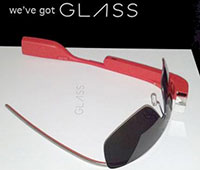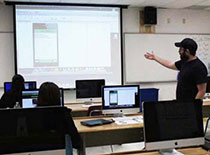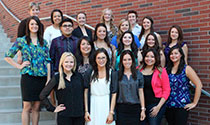
J&PR Wired
Yes, It's Google Glass
By Natalie Norris
Smartphones – most notably the iPhone – came on the scene in 2007 and have revolutionized the way our society communicates.
It's more than common to see a person with an iPhone or an Android in-hand, head down and staring at the screen.
Smartphones were a tremendous leap in communication, but the real question is how will we connect in the future?
Google Glass may be one answer.
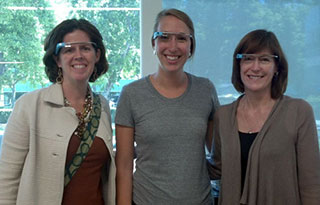
Chico State journalism and public relations students and faculty started beta testing Glass in June 2013, well before it was available to the general public.
The department purchased the device after Chair Susan Wiesinger entered a Google Glass contest promoted on Google Plus and Twitter. Wiesinger ended up "winning," and with the help of a $1,699 donation from alumni, J&PR owned one of the first thousand or so pairs of Google Glass in the nation.
The device is a titanium headpiece you wear much like glasses. It functions roughly as a hands-free smartphone. Instead of looking down at the screen in your hands, Glass allows you to look up and through a small prism right above eye level.
Whoever is wearing Google Glass has the authority to say what it wants the Glass to do and it responds within seconds. Current capabilities include texting, emailing, taking photographs ("OK, Glass, take a picture"), video and audio recording, posting to Twitter and Google Plus, checking time and weather, turn-by-turn directions, searching the Web and having breaking news stories read aloud to the wearer.
The department's Glass is bright orange - construction zone orange - a color chosen with intention.
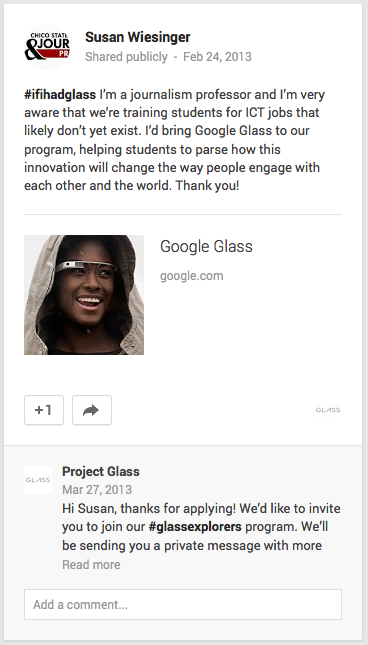
Credit: Susan Wiesinger
"We wanted to be sure everyone would notice it and link it to our program," Wiesinger said. "We also figured that if someone walked away with it the color would be easy to track."
The issue of the Glass being stolen is not a particular concern, Wiesinger said. That's because the device has an onboard GPS that is always on and feeds its location to Google.
The Glass has been used in a variety of classroom settings - from Mac Lab classes of 18 to large lecture classes of 75. Whether or not the students get to put the device on their faces, there is a benefit to Glass simply being in the room.
"You basically enter a whole new world with the Glass, which could potentially lead us to an entire new era of technology," said Julianna Young, a student who tried out the device in the Digital Media Startups class taught in fall 2013 by Professor Debra Johnson.
Students have been given the opportunity to check out the Glass for days at a time, with Wiesinger's approval and admonitions to use it with care.
"We want our students to think of what's ahead, to help them think about what might change in the near future," Wiesinger said. "They need to understand that smartphones aren’t the 'end all, be all' of technology. It all could change very quickly."
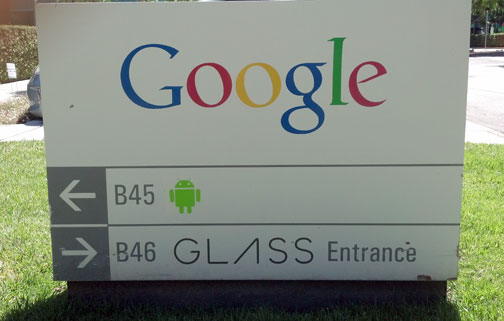
Sending the Glass out into the world is not without its risks; the Google Glass is, quite literally, irreplaceable.
"I mostly warn people not to drop it," Wiesinger said. "But that's a risk worth taking. The Glass has little value to the program if it's not in the hands of the students."
Stories published about the department's Glass acquisition led to an unusual collaboration across campus with the geography department. Cathie Benjamin, a geology instructor, used the Glass in a special topics course called Web Maps and Google Glass Apps that launched in early November.
The goal of the six-week course is for students to get experience with online mapping, Benjamin said. Using Google Glass for this effort is the students' central focus.
"The intention is to be able to add things into the directions on campus," Benjamin said. "With the Glass, it would be really neat for someone who is visiting to be able to point at one of the trees and maybe use a QR code or something like that to recognize it and get information about the trees."
http://www.google.com/glass/start/how-it-feels/
What it is:
- Titanium frame
- Touch screen
- Video and still camera
- Bone vibration instead of speakers
- Extremely light
What it does:
- Call, email, text, time, weather, calendar reminders, Web surfing
- Post directly to social media, including Twitter
- Still photos, via voice command
- Video, from 10 seconds to half-an hour
- Audio
- Turn-by-turn navigation
- News, which can be read by or read to the wearer
For the story of the glass first person, click here.
